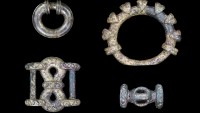Scientists 'Decode' 9,500-Year-Old Monument
| David Perry | | Oct 24, 2014 08:02 AM EDT |
A team of German scientists is closer to dating, and possibly "decoding" the cryptic Shigir Idol, a human-headed obelisk-like monument found in a western Siberian peat bog in 1890. Hewn from larch planks and covered in geometric designs and seven carved faces, the find is thought to be 9,500 years old.
Like Us on Facebook
It is the markings that have intrigued archaeologists most. Svetlana Savchenko, chief keeper of Shigir Idol at the Yekaterinburg History Museum and Mikhail Zhilin, leading researcher of the Russian Academy of Sciences' Institute of Archaeology, believes they represent a "code" interpreting the natural world, and are the sole remnant of the Middle Stone Age culture that created the idol.
"It is obvious that the elements of geometrical ornament had some meaning," said Savchenko and Zhilin to the Siberian Times.
While most scientists agree the series of lines nearest the head represents the rib cage, the carvings take on more symbolic meanings further down the body. A straight line could denote land or the horizon, ritualistically representing the boundary between earth and sky, water and sky, or the border between the worlds of the living and the dead.
"A wavy line or zigzag symbolized the watery element, snake, lizard, or determined a certain border. In addition, the zigzag signaled danger, like a pike," continued Savchenko. "A cross, rhombus, square, or circle depicted the fire or the sun, and so on."
The familiar school lesson that civilization began some 5,000 years ago along the banks of the Nile, Tigris-Euphrates, Indus, and Yellow rivers is increasingly becoming an antiquated notion. Archaeological finds across Eurasia prove sophisticated cultures extended from the Atlantic to the Pacific at the same time or earlier.
Ubar, a civilization in modern-day Oman, was concurrent with Mesopotamia; the site of Stonehenge was being ritually used by around 8,000 BC; Gobelki Tepe, a temple complex in southern Turkey is 11,000 years old and predates the domestication of animals and grain.
Curiously, the Shigir Idol does not seem to have been embedded in the ground or fastened to a foundation, leading authorities to theorize the monument leaned against something, either a tree or structure.
Lack of funding had prevented precise dating of the Shigir Idol, revered as one of Russia's great archaeological treasures. Its postulated age of 9,500 years, however, would make it twice the age of the Pyramids at Giza.
TagsShigir Idol, Siberia, Archaeology, Russia
©2015 Chinatopix All rights reserved. Do not reproduce without permission
- Pre-Historic Humans Lived in Homes where They Could Hardly Breathe
 6,000 Year Old Sacrificial Temple Unearthed in Ukraine
6,000 Year Old Sacrificial Temple Unearthed in Ukraine 2,000 Year Old Iron Age Bronze Warrior Chariot Found in England
2,000 Year Old Iron Age Bronze Warrior Chariot Found in England Ancient Cult Complex Uncovered in Israel
Ancient Cult Complex Uncovered in Israel- Archaeologists Unearth 90 Year-Old Hollywood Movie Set in California Desert
 Scottish Retiree Finds Viking Hoard with Metal Detector
Scottish Retiree Finds Viking Hoard with Metal Detector
EDITOR'S PICKS
-

Did the Trump administration just announce plans for a trade war with ‘hostile’ China and Russia?
-

US Senate passes Taiwan travel bill slammed by China
-

As Yan Sihong’s family grieves, here are other Chinese students who went missing abroad. Some have never been found
-

Beijing blasts Western critics who ‘smear China’ with the term sharp power
-

China Envoy Seeks to Defuse Tensions With U.S. as a Trade War Brews
-

Singapore's Deputy PM Provides Bitcoin Vote of Confidence Amid China's Blanket Bans
-

China warns investors over risks in overseas virtual currency trading
-

Chinese government most trustworthy: survey
-

Kashima Antlers On Course For Back-To-Back Titles
MOST POPULAR
LATEST NEWS
Zhou Yongkang: China's Former Security Chief Sentenced to Life in Prison

China's former Chief of the Ministry of Public Security, Zhou Yongkang, has been given a life sentence after he was found guilty of abusing his office, bribery and deliberately ... Full Article
TRENDING STORY

China Pork Prices Expected to Stabilize As The Supplies Recover

Elephone P9000 Smartphone is now on Sale on Amazon India

There's a Big Chance Cliffhangers Won't Still Be Resolved When Grey's Anatomy Season 13 Returns

Supreme Court Ruled on Samsung vs Apple Dispute for Patent Infringement

Microsoft Surface Pro 5 Rumors and Release Date: What is the Latest?









